The Developmental Potential of iPSCs Is Greatly Influenced by Reprogramming Factor Selection
Author(s)
Buganim, Yosef; Markoulaki, Styliani; van Wietmarschen, Niek; Wu, Tao; Ganz, Kibibi; Akhtar-Zaidi, Batool; He, Yupeng; Abraham, Brian J.; Porubsky, David; Kulenkampff, Elisabeth; Shi, Linyu; Gao, Qing; Sarkar, Sovan; Cohen, Malkiel; Goldmann, Johanna; Nery, Joseph R.; Schultz, Matthew D.; Ecker, Joseph R.; Xiao, Andrew; Lansdorp, Peter M.; Hoke, Heather Ashley; Jaenisch, Rudolf; Faddah, Dina A.; Young, Richard A.; ... Show more Show less
DownloadJaenischThe developmental.pdf (731.5Kb)
PUBLISHER_CC
Publisher with Creative Commons License
Creative Commons Attribution
Terms of use
Metadata
Show full item recordAbstract
Induced pluripotent stem cells (iPSCs) are commonly generated by transduction of Oct4, Sox2, Klf4, and Myc (OSKM) into cells. Although iPSCs are pluripotent, they frequently exhibit high variation in terms of quality, as measured in mice by chimera contribution and tetraploid complementation. Reliably high-quality iPSCs will be needed for future therapeutic applications. Here, we show that one major determinant of iPSC quality is the combination of reprogramming factors used. Based on tetraploid complementation, we found that ectopic expression of Sall4, Nanog, Esrrb, and Lin28 (SNEL) in mouse embryonic fibroblasts (MEFs) generated high-quality iPSCs more efficiently than other combinations of factors including OSKM. Although differentially methylated regions, transcript number of master regulators, establishment of specific superenhancers, and global aneuploidy were comparable between high- and low-quality lines, aberrant gene expression, trisomy of chromosome 8, and abnormal H2A.X deposition were distinguishing features that could potentially also be applicable to human.
Date issued
2014-09Department
Massachusetts Institute of Technology. Department of BiologyJournal
Cell Stem Cell
Publisher
Elsevier
Citation
Buganim, Yosef, Styliani Markoulaki, Niek van Wietmarschen, Heather Hoke, Tao Wu, Kibibi Ganz, Batool Akhtar-Zaidi, et al. “The Developmental Potential of iPSCs Is Greatly Influenced by Reprogramming Factor Selection.” Cell Stem Cell 15, no. 3 (September 2014): 295–309. © 2014 Elsevier Inc.
Version: Author's final manuscript
ISSN
1934-5909